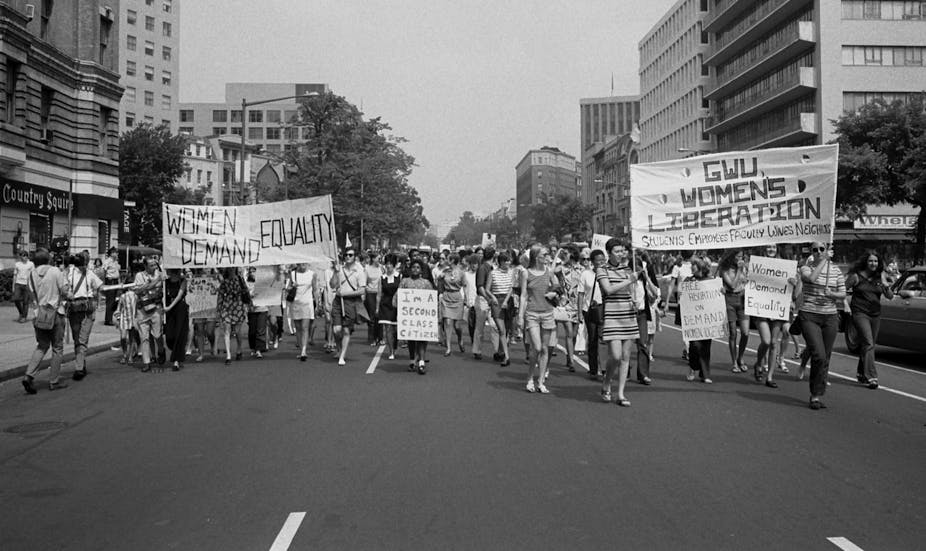The past four decades have produced gains around the world for women and girls in literacy, formal education, life expectancy, workforce participation and access to some professions. We have also seen new forms of misogyny, continued domestic violence, unabated rape, casualisation of women’s labour and reassertions of masculine authority.
Women are now more visible in politics, but are still almost wholly excluded from the top levels of transnational corporate management, religious authority, control of technoscience and military power.
This turbulent history has an intellectual dimension. We have created a new field of knowledge – and conflicting theories of gender.
Next year will be the 20th anniversary of the United Nations’ Beijing Declaration, a landmark statement on women’s rights. UN Women is gearing up for a big event to mark the anniversary and renew the struggle for gender equality.
Next year is also the 40th anniversary of the first World Conference on Women, held in Mexico City. That conference launched the UN process. It was itself triggered by a remarkable worldwide mobilisation, the Women’s Liberation movement.
A global gender mobilisation
Women’s Liberation launched powerful critiques of conventional beliefs about gender, especially two. First, the idea that men’s and women’s natures are fixed – whether by God or biology – and social inequality simply reflects their different characters. Second, the notion that breadwinner/housewife or aggressor/nurturer are divisions needed for the stability of society and can only be changed at the price of chaos.
In a key move, feminists such as Heleieth Saffioti and Kate Millett saw gender relations as a matter of social power – often enforced by violence. To some, this was an outgrowth of capitalism; to others, a system of power in its own right. The ancient term “patriarchy” was revived as a name for the entrenched social power of men and subordination of women.
A softer version of Women’s Liberation theory emphasised the social norms that define appropriate behaviour for women and men. The term “sex role” (later, “gender role”) came into widespread use for this idea. Boys and girls were thought to be socialised into restrictive roles as they grew up. The pioneering Australian report Girls, School and Society from 1975 is a classic of this approach.
Leaving simple gender divides behind
Some thinkers saw only two categories, men and women, and a gulf of difference between them. Several trends demanded a more complex view.
One was the rise of Gay Liberation, whose critique of homophobia among straight men and women showed important divisions within the main gender categories.
Another was concern with class and race. The idea that patriarchy and capitalism support each other as a dual system had some influence.
Later the looser idea of “intersectionality” proposed by Kimberlé Crenshaw became very popular. In this concept, gender inequalities are seen as criss-crossing inequalities of class, race, sexuality, disability, age and so on to create a grid of differing social situations, some with intensified oppression.
Post-structuralist thought, treating gender as a subject position constructed in discourse, also had the effect of emphasising diversity, in this case diversity of gender identities.
In the 1980s and 1990s, what had been a minor discussion of the “male role” grew quickly. Social researchers found multiple forms of masculinity and showed that gender hierarchies exist among men, as well as between men and women.
As this research expanded around the world, and sexuality was linked to gender, the field of knowledge called women’s studies was often redefined as “gender studies”. But this was controversial, as it seemed to reject the historic link with women’s activism.

In 1990 the philosopher Judith Butler published Gender Trouble, which rapidly became the most influential feminist text since Simone de Beauvoir’s The Second Sex. Butler adapted post-structuralist ideas to argue there is no fixed identity for women on which feminism could be based. Gender does not express an underlying essence but is “performative”, i.e. brought into existence by the very actions that exemplify it.
This idea became central in queer theory, which has continued to emphasise the underlying fluidity of sexuality and sees gender as an effect of heteronormativity – that is, the imposition of heterosexual patterns of identity.
But alternatives to post-structuralism were also emerging. Sociologists such as Sylvia Walby developed models of gender as a multi-dimensional social structure. Studies of organisations – corporations, armies, schools – generally showed permanence, not fluidity, in gender arrangements. Much of the debate about “work-life balance” and the double shift rests on this point.
Philosophers such as Elizabeth Grosz emphasised the body as the point of reference for gender, and a new feminist materialism has been increasingly influential.
A geopolitical knowledge shift
Perhaps the most important change, however, has been a shift in the geopolitics of knowledge. Early critiques of the white, middle-class and “Western” character of mainstream feminism – developed in Australia by Aileen Moreton-Robinson – have been backed by impressive growth of gender research around the global south. In masculinity studies, for instance, key contributions have come from India, South Africa, Chile and Australia.
The agenda is changing. For instance, the Indian economist Bina Agarwal has shown how the land is a key issue for gender analysis. The gender dynamic in environmental change is now an important concern. And new concepts such as the “coloniality of gender” – emphasising how modern gender patterns are products of global imperialism – are under debate.
How much this thinking will feed into the policy debates at the United Nations we have yet to see. Policy language often lags behind social science. But there’s no doubt that the ferment of ideas around gender relations continues.

